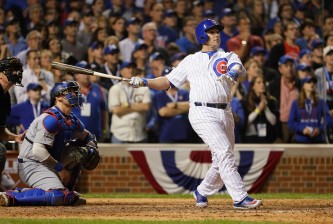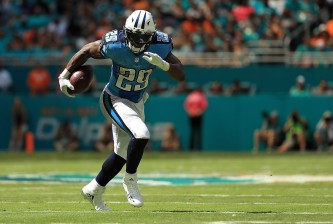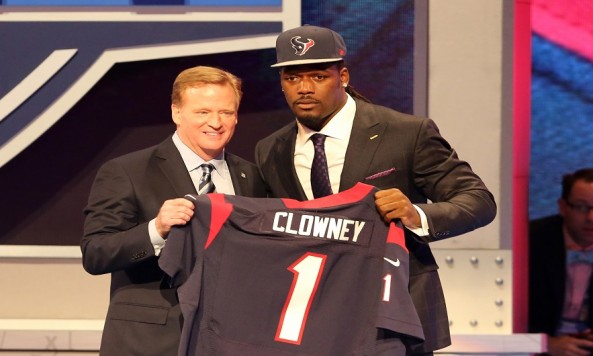After three months of analysis and three days of the actual event, the 2014 NFL draft is behind us.
No more infinite mock draft permutations. There is now only one board, and the names in each slot will never change. Some teams will look back and wish the names could change, but not every team.
Here are the seven teams who drastically improved their rosters between the time Jadeveon Clowney received his No. 1 jersey and new teammate Lonnie Ballentine received his No. 256 Mr. Irrelevant jersey.
Atlanta Falcons
The Falcons addressed their two biggest needs: Getting to the opposing quarterback and protecting their own quarterback.
Matt Ryan was sacked 44 times last year, so the Falcons pumped their offensive line with Hall of Fame bloodlines by drafting Texas A&M tackle Jake Matthews, son of former Houston Oilers/Tennessee Titans offensive lineman Bruce Matthews. The elder Matthews’ bust resides in Canton.
Matthews, the No. 6 pick, also is the cousin of Green Bay Packers linebacker Clay Matthews. Draft busts do not run in the family.
Lamar Holmes is the Falcons’ top remaining right tackle from last year, and he was responsible for 10 sacks according to Pro Football Focus.
On the other side of the ball, the Falcons’ defense sacked the quarterback 32 times last season. Only the Chicago Bears and Jacksonville Jaguars had less. The Falcons couldn’t get Khalil Mack because the Raiders took him one spot ahead of them. They did take three outside linebackers, however, starting with Notre Dame’s Prince Shembo in the fourth round. Shembo made 24.5 tackles for loss in college to go with 19.5 sacks. The Falcons buttressed that pick with two more outside ‘backers, Yawin Smallwood of Connecticut and Tyler Starr of South Dakota, in the seventh round.
Then there’s the wild-card of the Falcons’ 2014 draft. They chose Minnesota defensive tackle Ra’Shede Hageman at No. 37 to put the finishing touch on their offseason defensive line construction. They’ve already signed Tyson Jackson and Paul Soliai. The 6’6″, 310-pound Hageman was dominant at times, recording 13 tackles for loss and breaking up eight passes in 2013. He disappeared for long stretches, though, and is a bust risk.
Houston Texans
If Jadeveon Clowney fulfills his potential, goes to multiple Pro Bowls and helps the Texans win a Super Bowl, this draft gets an A+. But the success of the Texans’ draft doesn’t end with Clowney.
It took on a smash-mouth theme on offense with the selection of UCLA’s Xavier Su’a-Filo, the top pure guard in the draft, in the second round and 6’5″, 265-pound Iowa tight end C.J. Fiedorowicz in the third round. Then in the sixth round, the Texans took 6’2″, 223-pound running back Alfred Blue of LSU and 6’1″, 265-pound Auburn fullback Jay Prosch.
Then there’s the Texans’ draft-day steals. They traded up to catch Notre Dame nose tackle Louis Nix III as he was falling in the third round and snagged slipping Pittsburgh quarterback Tom Savage in the fourth round, showing they’re not content with Case Keenum.
Jacksonville Jaguars
The Jaguars weren’t the most draft-savvy team on Day One. They took Blake Bortles with the third overall pick even though there are no top-three, franchise-saving quarterbacks in this class. They could have taken Khalil Mack or Sammy Watkins and then taken a quarterback with just as much upside as Bortles early in the second round.
However, the Jags recovered from that misstep on Day Two and feasted on this draft’s wide receiver depth. They got a first-round receiver in the second round with USC’s Marqise Lee. Later in the round, the Jaguars took a bigger receiver who’s hard to bring down in 6’3″ Allen Robinson of Penn State. Teamed with Cecil Shorts and Ace Sanders, the Jaguars’ receiving corps now packs a little punch. And even if Bortles doesn’t start right away, he’s a better backup to Chad Henne than Ricky Stanzi or Matt Scott.
Jacksonville turned its attention to defense on Day Three, taking Oklahoma cornerback Aaron Colvin in the fourth round. Colvin is a versatile defensive back who broke up 14 passes in 2012, but tore his ACL before the Senior Bowl. It’s an investment for the Jaguars and they can stash him away for a year.
The Jaguars also were tied with the Bears for the fewest sacks in the NFL last season with 31. They attempted to fix that in the fifth round with defensive end/linebacker hybrid Chris Smith of Arkansas. Smith had 30.5 tackles for loss and 21.5 sacks in college.
New Orleans Saints
For a team that was second in the NFL with 307.4 passing yards in 2013, the Saints needed help at wide receiver, and they traded up to No. 20 to draft Oregon State’s Brandin Cooks in the first round.
Tight end Jimmy Graham (86 catches) and running back Pierre Thomas (77 catches) fueled the Saints’ air attack. Their leading receiver was Marques Colston with 75 catches, but he turns 31 next month. Their No. 4 and No. 5 pass catchers last year, Darren Sproles and Lance Moore, are gone.
Cooks led the nation with 1,730 receiving yards last year and caught 128 passes for 16 touchdowns. Then he ran a 4.33-second 40-yard dash at the NFL Scouting Combine. He can join forces with Kenny Stills (20 yards per reception) to add a vertical threat to the Saints’ offense.
The Saints also needed a cornerback opposite Keenan Lewis, who intercepted four passes last season. Free-agent signing Champ Bailey, who will be 36 next season, is nothing more than a stopgap measure. Taking a page out of the Super Bowl champions’ book, the Saints drafted a large cornerback in Stanley Jean-Baptiste with the No. 58 pick in the second round. The 6’3″, 218-pounder broke up 25 passes in three years at Nebraska and returned two interceptions for touchdowns. The Saints will need him to cover the Tampa Bay Buccaneers’ Mike Evans and the Carolina Panthers’ Kelvin Benjamin, two towering rookie receivers in the NFC South.
New York Jets
Ed Reed didn’t have much left, but he scraped the bottom of the mustard jar with three interceptions after the Jets acquired him during the 2013 season. He’ll be 36 in September, though, and might have played his last snap. That leaves Dawan Landry, who’s 31, and Antonio Allen, who struggled in pass coverage last season. Calvin Pryor intercepted seven passes, broke up 18 and forced nine fumbles in three years at Louisville and the Jets made him the No. 18 pick.
In the second round, the Jets drafted Texas Tech tight end Jace Amaro, who caught 106 passes last season. At the NFL Scouting Combine, Amaro tied for second among tight ends with 28 reps in the bench press and was fifth in his positional unit with a 4.74-second 40-yard dash.
It doesn’t look like Kellen Winslow is coming back next season, and he caught just 31 passes anyway. That leaves Jeff Cumberland, with 58 catches in four years, as the Jets’ top remaining tight end. Amaro might not be as productive in the pros as Eric Ebron, but he’s a truer tight end and looks like the Day 1 starter for the Jets.
Cornerback, with the loss of Antonio Cromartie, and wide receiver were the Jets’ other glaring needs. Since they didn’t address them in the first two rounds, they took advantage of their 12-pick draft and went with volume, choosing two corners and three receivers.
At cornerback, their choices were injury-prone Dexter McDougle of Maryland in the third round and Brandon Dixon of Division II national champion Northwest Missouri State in the sixth round.
Their first receiver chosen was 5’9″, 165-pound Jalen Saunders of Oklahoma. He caught 62 passes in 2012 and 61 in 2013 and has returned three punts for touchdowns. He’s the most likely candidate to be the deep-threat complement to Eric Decker. For insurance, the Jets added Shaq Evans of UCLA later in the fourth round and Quincy Enunwa of Nebraska, who caught 12 touchdown passes last year, in the sixth round.
As long as one pick pans out at each of those positions, the Jets will enter 2014 with an improved roster after nearly missing the playoffs at 8-8 last year.
Oakland Raiders
The Raiders were 18th in the NFL with 38 sacks in 2013. They signed LaMarr Woodley, but the injury-prone former Steeler isn’t the answer. He has just nine sacks in the last two and a half years. So the Raiders used the No. 5 pick to take Buffalo linebacker Khalil Mack. Unlike Woodley, Mack has increased his sack production every year. He want from 4.5 sacks to 5.5 sacks to eight sacks to 10.5 sacks in 2013. The 6’3″, 251-pounder is the NCAA’s all-time leader with 75 tackles for loss and 16 forced fumbles. He’ll instantly upgrade the Raiders’ pass rush.
In the second round, the Raiders took Fresno State quarterback Derek Carr with the No. 36 pick. Carr led the nation with 5,083 passing yards and 50 touchdown passes last year. The Bulldogs’ spread offense might have boosted those stats, but the Raiders needed to make a splash at quarterback with retread Matt Schaub as the incumbent.
Oakland addressed the interior of its defense with 334-pound defensive tackle Justin Ellis in the fourth round and later in the round recognized the increasing need across the league for lengthy cornerbacks by taking 6’3″ Keith McGill of Utah.
St. Louis Rams
The Rams made history by drafting Michael Sam in the seventh round. The Missouri defensive end can become the NFL’s first openly gay player.
It’s what the Rams did in the early rounds that could be historic from a football standpoint. This was their last draft with an extra first-round pick from the Robert Griffin III trade, and they took full advantage of it.
St. Louis grabbed Auburn offensive tackle Greg Robinson second overall. NFL Network analyst Mike Mayock compares the 6’5″, 332-pound Robinson to seven-time Pro Bowler Orlando Pace. He could start on Day One at right tackle.
At No. 13, the Rams took Pittsburgh defensive tackle Aaron Donald, a top-10 talent. Donald, who led the nation with 28.5 tackles for loss in 2013 and forced four fumbles, will beef up a defensive line that’s bookended by Robert Quinn (19 sacks) and Chris Long (8.5 sacks). He’ll be in the mix with Michael Brockers and Kendall Langford at defensive tackle.
Lamarcus Joyner, a 5’8″, 184-pound senior from Florida State, was the Rams’ second-round pick, No. 41 overall. Joyner can line up at cornerback and safety, both positions of need for a defense that allowed the most yards per pass attempt (8.1) last season and tied with the Oakland Raiders in yielding the highest completion percentage (68.1). The Rams also stocked up their secondary with fourth-round strong safety Mo Alexander of Utah State, who also has experience at linebacker, as well as Missouri cornerback E.J. Gaines in the sixth round and Ohio State free safety C.B. Bryant in the seventh round.
The Rams also got Zac Stacy some help with Auburn running back Tre Mason in the third round. Stacy ran the ball 250 times at a rate of 3.9 yards per carry last season and will be joined by a guy who ran for 23 touchdowns in 2013.























